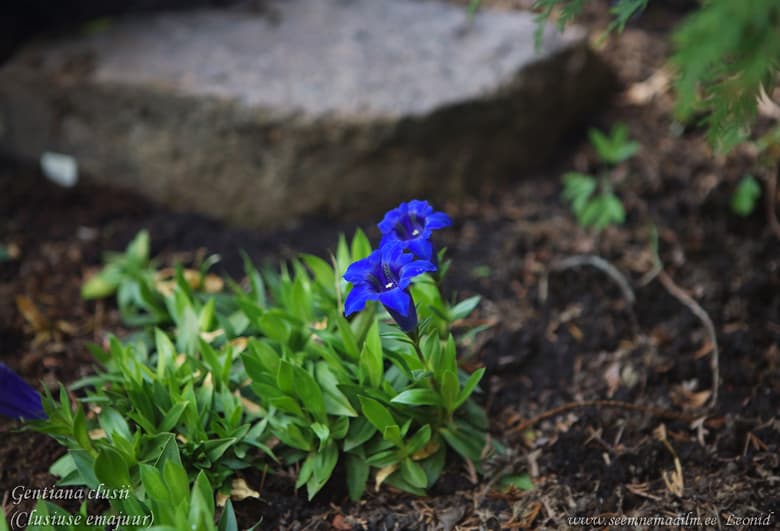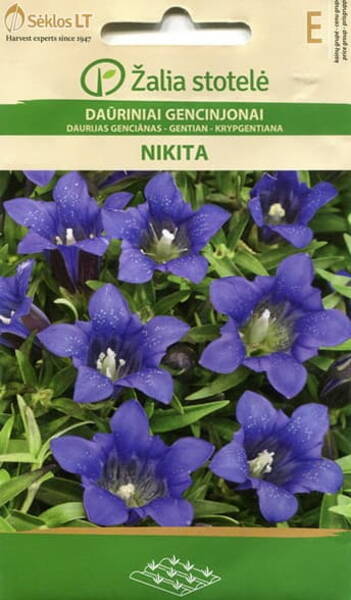Spotted gentian "Nikita".
Physical Characteristics: perennial growing to 0.3m. It is hardy to zone 4. It is in flower in August. The flowers are hermaphrodite (have both male and female organs) and are pollinated by Bumblebees and butterflies. We rate it 1 out of 5 for usefulness. The plant prefers light (sandy), medium (loamy) and heavy (clay) soils and requires well-drained soil. The plant prefers acid, neutral and basic (alkaline) soils. It can grow in semi-shade (light woodland) or no shade. It requires moist soil.
Habitats and Possible Locations: cultivated Beds.
Cultivation details In general, gentians require a moist well-drained soil in a sheltered position, a certain minimum of atmospheric humidity, high light intensity but a site where temperatures are not too high. They are therefore more difficult to grow in areas with hot summers and in such a region they appreciate some protection from the strongest sunlight. Most species will grow well in the rock garden. This species prefers an alkaline soil, but can succeed in neutral to slightly acid conditions. A moisture loving plant, preferring to grow with full exposure to the sun but with plenty of underground moisture in the summer, it grows better in the north and west of Britain.
Many of the plants and seeds offered under this name are wrongly identified, usually being G. gracilipes, G. cruciata or G. decumbens. Plants are intolerant of root disturbance.
Propagation seed: best sown as soon as it is ripe in a light position in a cold frame. It can also be sown in late winter or early spring but the seed germinates best if given a period of cold stratification and quickly loses viability when stored, with older seed germinating slowly and erratically. It is advantageous to keep the seed at about +10°C for a few days after sowing, to enable the seed to imbibe moisture.
Following this with a period of at least 5-6 weeks with temperatures falling to between 0 and -5°C will usually produce reasonable germination. It is best to use clay pots, since plastic ones do not drain so freely and the moister conditions encourage the growth of moss, which will prevent germination of the seed.
The seed should be surface-sown, or only covered with a very light dressing of compost. The seed requires dark for germination, so the pots should be covered with something like newspaper or be kept in the dark. Pot up the seedlings into individual pots as soon as they are large enough to handle and grow on in light shade in the greenhouse for at least their first winter.
The seedlings grow on very slowly, taking 2-7 years to reach flowering size. When the plants are of sufficient size, place them out into their permanent positions in late spring or early summer. Division in March.
Most members of this genus have either a single tap-root, or a compact root system united in a single root head, and are thus unsuitable for division. Cuttings of basal shoots in late spring.

Горечавка даурская "НИКИТА" - Gentiana dahurica.
Многолетник, растущий куртинами, с прикорневой розеткой листьев и приподнимающимися или прямыми цветоносами и короткими боковыми побегами, высотой до 30 см. Цветки колокольчатые, интенсивно тёмно-синие, крупные, расположены на верхушках стеблей и в пазухах верхних листьев. Горечавка зимостойка. Пригодна для выращивания и реализации в контейнерах. Используется для миксбордеров, в рокариях. Прекрасно будет смотреться сплошным ковром на газоне.
ПОСЕВ: основные условия прорастания - достаточная влажность семян, свободный доступ к ним кислорода и благоприятная температура (в данном случае от +15 до +20 °С). Можно провести промораживание сухих семян (до -10°, -20 °С). Но предпочтительнее предварительная кратковременная стратификация. Но самый простой и надёжный способ – это посеять семена в открытый грунт под зиму. Земля должна быть хорошо просеяна и выровнена. Сеют поверхностно, т.к. для прорастания семенам необходим свет. Впоследствии сеянцы вместе с комом земли при обильном поливе пересаживают на постоянные места по схеме 25x35 см. Хорошо растёт в полутени на влагоёмких глинистых хорошо удобренных и хорошо дренированных почвах.
УХОД: поливы, подкормки комплексным минеральным удобрением, обеспечение дренажа. В бесснежные зимы – укрытие.
ЦВЕТЕНИЕ: июль - август.
Eng.: Spotted gentian. Suom.: Rönsykatkero. Sven.: Sibirisk gentiana.











